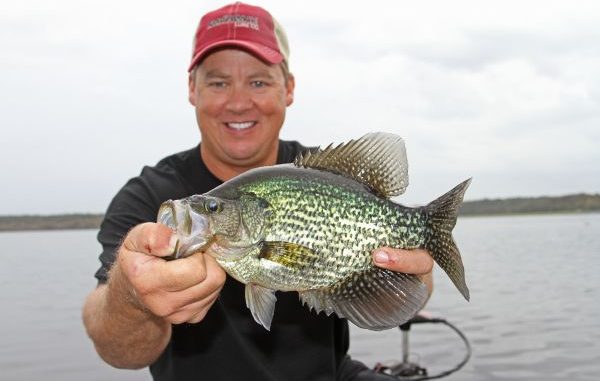
Umbrella rigs aren’t just for bass fishing anymore. Learn how you can use the multi-bait outfits to force crappie into feeding frenzies.
So I’m discussing bass-stocking strategies with a fish hatchery biologist and he explained that the concept of manipulating brood stock with light and temperature moderations can prompt the fish to spawn early and provide larger fingerling bass to stock in conjunction with the threadfin shad spawn.
Releasing smaller fingerlings, he noted, stocks the lake with young bass not yet large enough to capitalize on the bounty of shad fry.
Moreover, when stocking tiny fingerlings, you run the risk of releasing them in front of a crappie school — and then it’s pretty much game over.
Indeed, the world is a buffet line for crappie, and a wad of baitfish presents an irresistible image to these feisty fish. Gluttons? Yeah, maybe that’s the case; but it’s also about feeding competition. If you don’t eat it, there are plenty of schoolmates who’ll be happy to take your portion.
So, we have lots of different ways of putting several baits in the water, but how about presenting those little jigs and swim baits in clusters that actually simulate pods of baitfish?
Sound familiar? Well, if you’ve paid even minimal attention to the bass-fishing market over the past couple of years you know that the so-called “umbrella rig” has amassed quite the reputation for tempting bass — often in the more challenging scenarios of suspended fish.
But lately anglers have found the same principle, in a scaled-down form, that attracts bass also interests crappie.
Realistically, these multi-armed rigs aren’t likely to produce all-day, every-day, but windows of opportunity and applicability exist.
I recently asked Dr. Mike Allen, professor of Fisheries and Aquatic Sciences at the University of Florida, for some insight into why the umbrella rig appeals to gamefish. As he explained, bait schools under attack will scatter, but all those loose minnows want to reform into their protected order, so they’ll start gathering in little pods that eventually reconnect into the larger entity.
But while all those fragmented clusters are buzzing around in the open, they’re highly vulnerable to predators like crappie. Safe to say that a well-placed umbrella rig can play right into an existing image crappie have deemed enticing.
“Baitfish schooling are harder to target than two or three in a small group,” Allen said. “(Umbrella) rigs look like those smaller schools. You hardly ever see schools of like five (baitfish) swimming in the wild. When you see that it’s because a predator has broken up the school.
“These rigs look like exactly what they want, which is a small school.”
Whether by direct action of their own or as a response to adjacent bass feeding, crappie definitely notice little groups of baitfish rambling about all by their lonesome. Anything so vulnerable won’t cross their radar unmolested.
Even the most-aggressive fish, sometimes needs a “look this way” announcement. Multiple baits — especially when teamed with flashy blades — present a greater profile for crappie to spot, while greater water displacement and vibration means the predators detect the target approaching from farther away.
Also, when a wad of fish are slow to start feeding, running a multi-arm rig across the crappie’s radar can have a similar effect as using a crankbait to light a fire under a school of suspended bass.
“Sometimes, you can run one of these rigs through them to fire up the school,” said Bassmaster Elite Series pro and crappie aficionado Terry Scroggins. “It’s just like running a crankbait through a school of bass.”
There’s no overstating the value of diversity in sport fishing. Sometimes, the fish just see too much of a particular bait and they’re looking for something new. Even if your multi-arm rig bears baits similar to what has been dropped or trolled over fish’s heads, the appearance of what seems to be a cluster can be just the ticket to push them over the edge.
Ups and downs
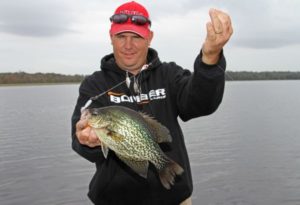
Working single jigs over brush piles boasts a long history of crappie success, but consider this: For a hungry predatory, if one bait is good, then two is great and more is — well, you get the picture.
So locate a bunch of crappie over a brush pile, channel turn or any other point of attraction, and a mini-umbrella rig vertically presented creates a mighty appealing opportunity.
As Scroggins pointed out, proximity is critical.
“You want to keep (the umbrella rig) above the brush, so it doesn’t get down in there and get hung,” he said.
Time to troll
A veteran long-liner, crappie tournament pro Mark Williams likes to mix things up and dial in what the fish want.
So, when a friend asked him to try his locally produced crappie umbrella rig, Williams obliged — and quickly discovered the power of pulling four to six bait clusters behind his boat.
Targeting the spring aggregations of spawning crappie, he said, is always a good bet.
“I troll my rigs at .5 to .7 mph,” Williams notes. “We let (the rigs) out until they just touch the bottom, and then reel up until they’re just off the bottom.”
Williams has also fared well by pulling mini-umbrella rigs down creek channels for suspended post-spawn crappie. In either scenario, he finds that jig and tail selection play a big role in the mechanics of the rig’s presentation.
Angled swim-style heads that cut through the water with minimal resistance are the common choice for most umbrella rig-casting scenarios. But for long lining, Williams knows that the faster his rig sinks the closer to the boat he must keep it.
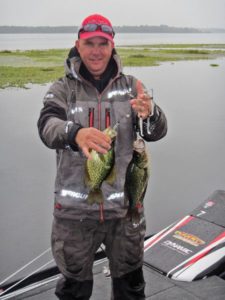
For optimal presentation, he goes with round 1/32-ounce Mr. Crappie jigheads and Mr. Crappie curly tail grubs.
“The extra drag and the lift that those (active tails) create help keep the baits higher in the water,” Williams said. “That enables you to keep your bait up, and it allows you to pull your baits farther back.
“I think that’s the reason long-lining is effective: You’re keeping those baits farther away from the boat. The boat has gone by and they’re not hearing trolling motor noise, the boat slap.”
Elsewhere, Pickwick Lake guide Brad Whitehead has found great success by pulling two-armed crappie rigs with a tactic known as “side trolling.”
Essentially, he mounts his trolling motor to the side of his boat rather than the common positions at the bow or stern. This enables him to position anglers at both ends of the boat and pull the tandem-style Blakemore Reality Shad Buffet Rigs across broad swaths of water.
Whitehead said he keeps a couple of Buffet Rigs tied on year-round, but the side-trolling technique seems to excel from late winter through the spring.
And deploying as many as 10 rods over a common depth range gives the crappie lots of options, while the boat’s lateral progression gives anglers at the bow and stern equal opportunity.
The key, Whitehead notes, is a brisk trolling pace of about .5 to .9 mph.
“This is a very productive way of presenting these baits,” he said. “It just ups your chances because the crappie have that one split second to decide, and they usually bite so they don’t miss (a meal). Having (up to) 20 baits in the water is pretty good odds.
“I’m covering so much water and, in my head, my odds of catching active fish are greater than sitting over them with one jig.”
Whitehead pointed to another benefit: Due to that now-or-never premise, crappie tend to hit trolled baits harder than they do static presentations, so strikes are more easily detected.
Options and benefits
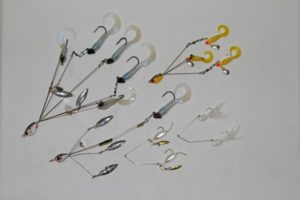
Complementing the umbrella rig’s benefit of quantity, you also have an amplified element of experimentation.
Jigs have always offered quick-change flexibility that allows anglers to test various body types and colors, but multiple arms means multiple test points.
In other words, if the crappie are slow to respond, try different baits until you determine some pattern of preference.
Throughout the process, keep an open mind — there’s no rule stating that you have to rig only jigheads and plastic bodies.
In shallow water, for example — or if the crappie are frequently chasing baits to the surface — you might not want that rig sinking too far. Try lightening up by replacing the more-common leadheads with small swim-bait hooks sized to fit your bait.
For a more-aggressive approach, don’t hesitate to rig one of those two-armed rigs with a pair of small hard baits like the Strike King’s Bitsy Minnow or Rapala’s Ultra Lite Minnow. Twin Road Runners, tiny spinnerbaits or the classic beetle spins will also make for a crappie-tempting package.
As is the case in the bass world, resistance to the multi-arm crappie rig might persist, but there will always be those innovative types whose willingness to try something new avails new avenues of opportunity.
Experimentation, modification and observation — these are the pillars upon which modern tactics are built. Give these rigs a fair shake and you might be surprised what shakes back.
Casting call
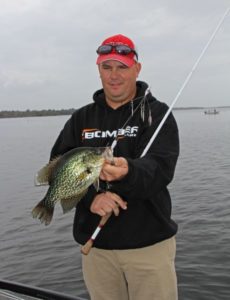
Unlike those shoulder-straining full-size umbrella rigs designed for largemouth bass, the crappie versions won’t send you to the chiropractor after a weekend on the lake.
For the lighter two-armed rigs, you’ll find spinning tackle easier to handle, but make sure your rod has enough backbone to handle the higher level of resistance without doubling over on a standard retrieve.
A rod with a soft tip and plenty of backbone lets you load up and launch a good cast while retaining all the fish-fighting strength you’ll need if you nab a double- or triple-header of slabs.
Now, blind casting over likely areas is inherently more productive with multiple baits, but Scroggins said you’ll put the rig’s potential to better use by targeting crappie hangouts like brush piles or stake beds.
Preventing structure snags requires careful presentations, however, with close monitoring of your depth and retrieve speed. Scroggins said anglers can avoid this potential hazard altogether by targeting crappie over contours rather than structure.
“You want to look for those turns in the river channel,” he said. “That’s where the crappie like to school, so just idle the channel until you find one of those bends, toss out a buoy and then look for the schools of fish on your depth finder.”


